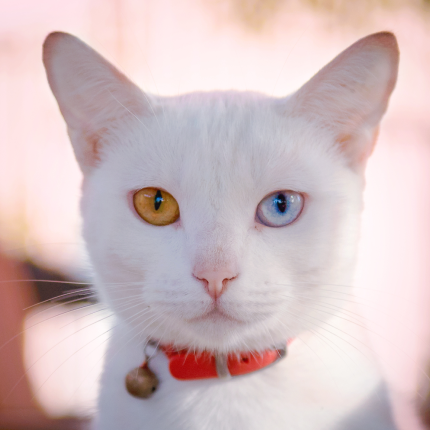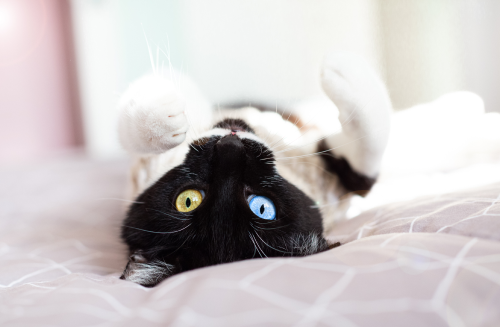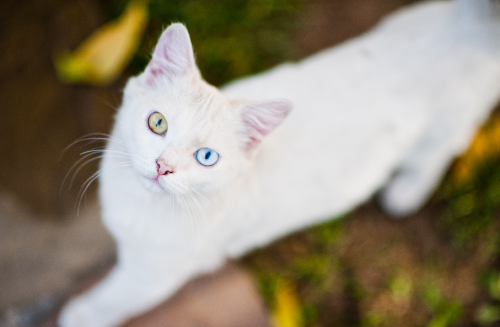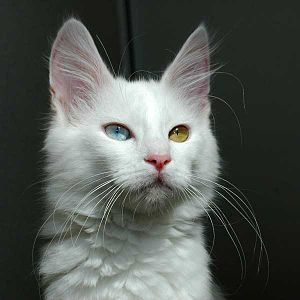The Odd-Eyed Cat (AKA Heterochromia)

 Cats are already beautiful and fascinating creatures, but people are bound to take notice when they have something as captivating as two different colored eyes.
Cats are already beautiful and fascinating creatures, but people are bound to take notice when they have something as captivating as two different colored eyes.
Odd-eyed cats always have one blue eye paired with either a green, yellow, or brown eye. This form of heterochromia occurs in other animals, including humans. Odd-eyed cats are most commonly white, but a cat of any color can be affected if it possesses the white spotting gene (a gene that determines a cat’s coat color).
advertisement
The Science
 During fetal development, stem cells migrate to different body parts, where they differentiate into other types of cells. Some stem cells migrate to the eye, becoming melanocytes and under certain conditions, melanocytes won’t reach the other eye. One eye will have melanocytes, which give it its pigmentation (green, amber, or brown), while the other eye remains blue due to the lack of melanin. This is due to migration sometimes being inhibited by the dominant white gene and the white-spotting gene.
During fetal development, stem cells migrate to different body parts, where they differentiate into other types of cells. Some stem cells migrate to the eye, becoming melanocytes and under certain conditions, melanocytes won’t reach the other eye. One eye will have melanocytes, which give it its pigmentation (green, amber, or brown), while the other eye remains blue due to the lack of melanin. This is due to migration sometimes being inhibited by the dominant white gene and the white-spotting gene.
It is also a common misconception that all odd-eyed cats are born deaf in one ear. Approximately 60–70% of odd-eyed cats can hear, so it’s not true. The aging process in cats causes about 10-20% of normal-eyed cats to become deaf. White cats with one or two blue eyes do, however, have a higher incidence of genetic deafness, with the white gene sometimes causing cochlear degeneration shortly after birth.
advertisement
The Turkish Angora Cat
 Turkey’s Ankara Zoo has a breeding program to preserve pure white Turkish Angora cats with blue and amber eyes. According to Turkish folklore, “the eyes must be as green as the lake and as blue as the sky,” so the zoo prized those Angoras with one blue eye and one amber eye.
Turkey’s Ankara Zoo has a breeding program to preserve pure white Turkish Angora cats with blue and amber eyes. According to Turkish folklore, “the eyes must be as green as the lake and as blue as the sky,” so the zoo prized those Angoras with one blue eye and one amber eye.
The Turkish Angora was almost extinct in Europe at one point, and the breed may have been lost entirely if the cats had not been kept in a Turkish zoo. Turkish Angoras are one of the two native breeds of cats in Turkey. The Ankara Zoo began a massive project to preserve and protect them. In addition to their scientifically and genetically sound breeding program, the zoo kept these cats in impeccable conditions and kept meticulous records. The Turkish people and government regarded their breeding program as a significant achievement.
Cats are captivating and beautiful creatures. We would all love to see the world through our furry friends’ eyes, but today, we will have to settle for a little bit of science behind heterochromia in cats.

Featured Articles

The Odd-Eyed Cat (AKA Heterochromia)
Cats are already beautiful and fascinating creatures, but people are bound to take notice when they have something as captivating as two different colored eyes. Odd-eyed cats always have one blue eye paired with either a green, yellow, or brown eye. This form of heterochromia occurs in other animals, including…

Why Do Cats Roll Over Into Their Backs But Not Let You Touch Their Bellies?
It’s common knowledge dogs love to have their tummies rubbed when they freely lay down before you and roll onto their backs. But, if you’re also familiar with cats, you know that when they roll onto their backs with their bellies exposed, rubbing the belly will most likely result in…

Greebles and Cats: The Origin and the Meaning
You may have seen an internet sensation concerning cats labeled “greebles.” Feel out of the loop? We’re here to help you. In 2019, Reddit user /user/literallyatree commented on a Reddit post about a cat that looks like it’s trying to slap a ghost. This user commented: “My family calls things…
